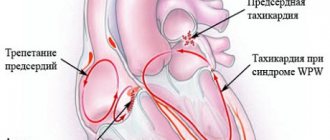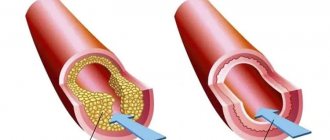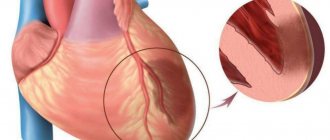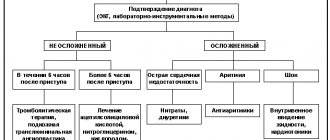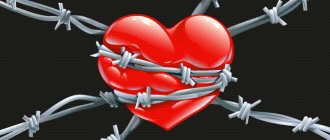Myocardial infarction is a focus of ischemic necrosis (death) of the heart muscle, resulting from an acute circulatory disorder in the coronary artery. Myocardial infarction is one of the most common forms of coronary heart disease (CHD). The condition poses a threat to human health and life and is the leading cause of death among adults in developed countries. Most often, symptoms of myocardial infarction are recorded in men (about 5 times more often than in women), and 70% of all sick people are aged 55–65 years. A heart attack manifests itself with extremely unpleasant symptoms: sharp pain in the chest, shortness of breath, cold sweat, and a feeling of fear. However, with timely identification of risk factors, diagnosis of a heart attack and provision of timely assistance during an attack of myocardial infarction in the clinic, it is possible to avoid tragic consequences.
Causes of heart attack
The direct cause of a heart attack is the sudden occurrence of an obstruction to blood flow in the branches of the coronary artery. In 95–97% of cases, such an obstacle is a blood clot formed as a result of atherosclerotic lesions of the arteries. In other cases, a heart attack occurs without any manifestations of atherosclerosis, and the main cause is a pronounced prolonged spasm of the coronary artery.
In extremely rare cases, myocardial infarction develops as a complication of other diseases (arteritis, developmental anomalies and injuries of the coronary artery, infective endocarditis, etc.). The likelihood of symptoms of an acute heart attack increases several times if the following risk factors are present:
- hyperlipoproteinemia (abnormal increase in the level of lipids and/or lipoproteins in the blood);
- old age (55 years and older);
- male gender;
- physical inactivity (lack of physical activity);
- obesity;
- smoking;
- diabetes;
- hypertonic disease;
- hereditary predisposition (presence of IHD in blood relatives).
Who takes care of the heart?
But there is also another group of risks - the so-called behavioral ones. Who do you think has a higher risk of developing a heart attack: the poor or the rich? It turns out that the poor man has it. Observations conducted in the United States found that the higher the average annual income in a family, the lower the likelihood that its members will develop heart attacks and strokes in the next ten years. Because rich people have more opportunities to maintain a healthy lifestyle. They are more likely to buy a membership to a fitness club and be more active. If you have money, it is easier to adhere to a healthy eating style - give up fast food, go on a fasting diet, and include healthy foods in your diet that are necessary for the perfect functioning of your heart. And a wealthy patient always has the opportunity to visit a cardiologist on time and conduct the necessary tests.
True, there is a risk factor that is difficult for a person with any income to protect themselves from: stress. Modern man lives under conditions of chronic stress, and the hormones released in this state have the opposite effect of insulin, which lowers sugar levels. The state of constant, elevated levels of glucose in the blood leads to disruption of many metabolic processes and the development of metabolic diseases, the consequence of which is, again, a heart attack.
Catch it if you can. How to prevent a heart attack
More details
Symptoms of a heart attack
In most cases, the first symptoms of myocardial infarction are increasing manifestations of a person’s existing angina:
- pain in the sternum (longer and more intense);
- an increase in the area of pain and the appearance of irradiation (spread of pain to other areas: left arm, shoulder blade, collarbone, jaw);
- a sharp drop in exercise tolerance;
- a significant decrease in the effect of taking nitroglycerin;
- development of shortness of breath at rest, dizziness, general weakness.
Symptoms of a heart attack rarely appear against the background of new-onset angina or after a period of long remission. Often, the occurrence of an acute heart attack is provoked by one of the following factors:
- severe stress;
- significant physical stress;
- severe overheating or hypothermia;
- surgery;
- sexual intercourse;
- binge eating.
The typical course of the disease is characterized by the fact that the main complaints are associated with such symptoms of a heart attack as severe pain, which is localized behind the sternum. The pain can be burning, squeezing, cutting. Often symptoms of myocardial infarction include pain spreading to the left arm, shoulder blade and shoulder. However, antianginal drugs such as nitroglycerin do not have an analgesic effect. Compared to an attack of angina, the duration of pain is increased: from 30 minutes to several days. Even slight physical activity or stress increases pain.
Most people note that the painful symptoms of a heart attack have a pronounced emotional overtones: there is a feeling of fear of death, hopelessness, doom, and intense melancholy. The person becomes easily excitable, may scream, and strive to constantly change body positions. In addition, symptoms of myocardial infarction are severe weakness, shortness of breath, excessive sweating, nausea, vomiting, and dry cough.
The examination reveals in patients such objective symptoms of a heart attack as pale skin with blue discoloration of the nasolabial triangle and nails, the skin is moist to the touch. The pulse rate rises to 90–100 beats per minute, while blood pressure rises slightly. Often in the first days, an increase in body temperature to 37–38 °C is detected.
Consequences of a heart attack
Myocardial infarction rarely goes away without leaving a trace. Its consequences in the form of complications can significantly reduce life expectancy. The most common complications of a heart attack are:
- early post-infarction angina;
- heart rhythm disturbances;
- cardiogenic shock (sharp decrease in myocardial contractility);
- acute cardiovascular failure;
- cardiac aneurysm (protrusion of the thinned wall of the heart);
- heart rupture (violation of its integrity).
After a heart attack, it is possible to return to a full life; the likelihood of this depends on many factors, including the timeliness and adequacy of treatment of the heart attack, the prevalence of tissue necrosis, and the presence of complications. Unfortunately, the mortality rate from a heart attack is high and amounts to about 35%. A third of those who have had the disease develop circulatory failure, in which people may lose their ability to work and become disabled.
Risk group
Character traits inherent in women such as caring for the family, worries about the fate of children, dedication and self-sacrifice contribute to their being at risk. Such women practically forget about themselves, do not care about their own health, ignore or simply forget about visiting a doctor for preventive purposes. Without paying due attention to the warning signs of the disease, they may end up in a situation where irreversible processes occur.
Women who live a lifestyle that is far from healthy are also at risk of having a heart attack. Those who engage in heavy (harmful) physical labor or suffer from chronic diseases are also not insured.
It is very important for women over 50 to see a cardiologist regularly.
Statistics show that the rate of cardiovascular disease is so high that women aged 30 or 40 may also be at risk. Therefore, preventive methods should be applied starting at an earlier age.
Diagnosis of myocardial infarction
In a typical course, the diagnosis of acute myocardial infarction is performed based on an analysis of the clinical picture of the disease. To confirm the diagnosis, electrocardiography and laboratory diagnostics are used. The presence of an atypical form can usually be determined only with the help of additional methods for diagnosing a heart attack. The main diagnostic signs of myocardial infarction are the following:
- prolonged pain (more than 30 minutes), which is not eliminated with nitroglycerin;
- characteristic pattern on the electrocardiogram;
- an increase in erythrocyte sedimentation rate (ESR), leukocytosis, detected by a general blood test;
- deviation of biochemical parameters from the norm (detection of C-reactive protein, increase in the level of fibrinogen, sialic acids);
- the presence in the blood of markers of myocardial cell death.
It is not difficult to distinguish between the symptoms of myocardial infarction and signs of other diseases with severe pain in the heart area (angina pectoris, pleurisy, pulmonary embolism, spontaneous pneumothorax, intercostal neuralgia, etc.) when diagnosing a heart attack. With an atypical course, it is more difficult: the abdominal form can be mistaken for food poisoning, peptic ulcer, pancreatitis, acute cholecystitis; cerebral form - for a stroke.
First aid for an attack
You can't help radically on your own. You need to call the emergency team. While the doctors are on their way, a number of actions need to be taken. The algorithm is as follows:
- Open a window or window
. When a heart attack develops, both the systemic and pulmonary circulation suffers. This means that the efficiency of gas exchange decreases significantly. Excess CO2 in liquid tissue makes adequate nutrition impossible. An increased supply of oxygen is required. In the absence of a special cylinder, adequate ventilation must be ensured. - Measure blood pressure, heart rate
. Signs of a heart attack in women over 50 years of age are blurred. It is necessary to find out what caused the feeling. - Give 1 tablet of Nitroglycerin
. It must at least partially relieve severe pain, which is extremely painful for the patient. If there is no beneficial effect, you can give another one after 10-15 minutes. It is not recommended to drink anything else. - Make the victim sit down
. It is impossible to lay it down, since there is a high probability of asphyxia and death from suffocation. In a semi-sitting position with a cushion placed under the back, the condition quickly returns to normal. The arms and legs should be below the level of the heart so that the peripheral blood flow does not decrease on the one hand, on the other, in order to avoid deterioration of hemodynamics. - Turn your head to the side
. In case of loss of consciousness. This will prevent aspiration of stomach contents when vomiting. After an episode, it is recommended to clear the mouth of food debris using a gauze roll placed on the fingers.
In case of cardiac arrest, perform direct massage. Place open palms one above the other and place them on the chest. Press rhythmically, at a speed of 100-120 movements per minute until normal cardiac activity is restored.
Treatment of heart attack
If qualified treatment of myocardial infarction is started in a timely manner, this largely determines the prognosis of the disease and the severity of the consequences. In the most acute and acute periods of the disease, hospital therapy is necessary. Treatment for a heart attack includes:
- relief of pain with analgesics, anesthesia with nitrous oxide for persistent pain;
- oxygen therapy – oxygen inhalations are performed using nasal catheters, flow rate 3–4 l/min;
- restoration of coronary blood flow using thrombolytic therapy;
- improving blood supply to the damaged area of the myocardium with the help of nitrates, β-blockers and calcium antagonists;
- prevention of heart rhythm disturbances using magnesium solution;
- stabilization of the emotional state with the help of sedatives, tranquilizers and psychotherapy;
- compliance with the daily regimen: first bed rest, after 2 weeks - ward rest, minimum physical activity (only dosed walking). The average duration of inpatient treatment for heart attack is 3 weeks.
- Compliance with the diet: diet during the acute period with the exclusion of “heavy” foods from the diet, increasing the frequency of meals and reducing the amount of food consumed at a time.
Prevention of heart attack
The goal of primary prevention of myocardial infarction is to combat coronary heart disease and eliminate risk factors. Quitting smoking, maintaining an active lifestyle, systematic moderate physical activity, maintaining normal body weight, and a balanced diet will help prevent the development of a heart attack.
Secondary prevention aims to combat the development of recurrent infarctions: preventive measures include the prescription of anticoagulants, β-blockers, and calcium antagonists. An important point is to ensure patency of the coronary artery. This can be accomplished by cardiac bypass surgery or stenting of cardiac vessels.
If you need an examination to identify risk factors or treat a heart attack, the ABC-Medicine clinic offers you its assistance. To ask any question you are interested in about diagnosing a heart attack or any other aspects of the problem, as well as to make an appointment with a specialist, call +7.


